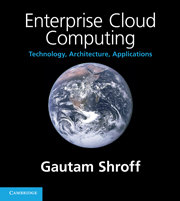Book contents
- Frontmatter
- Contents
- Preface
- List of abbreviations
- Part I Computing platforms
- Part II Cloud platforms
- Chapter 5 Cloud computing platforms
- Chapter 6 Cloud computing economics
- Part III Cloud technologies
- Part IV Cloud development
- Part V Software architecture
- Part VI Enterprise cloud computing
- References
- Index
Chapter 6 - Cloud computing economics
Published online by Cambridge University Press: 06 December 2010
- Frontmatter
- Contents
- Preface
- List of abbreviations
- Part I Computing platforms
- Part II Cloud platforms
- Chapter 5 Cloud computing platforms
- Chapter 6 Cloud computing economics
- Part III Cloud technologies
- Part IV Cloud development
- Part V Software architecture
- Part VI Enterprise cloud computing
- References
- Index
Summary
One of the reasons for the growing interest in cloud computing is the popular belief, propagated also by cloud providers, that by using public cloud offerings one can significantly reduce IT costs. In this chapter we examine the economics of cloud computing. Given that there are two varieties of cloud offerings, infrastructure clouds as well as platform clouds, we consider infrastructure costs as well as possible advantages in a development environment, including productivity. We look at cloud economics from the perspective of the user, as well as from that of the cloud provider. We also compare the economics of private and public clouds.
IS CLOUD INFRASTRUCTURE CHEAPER?
As of this writing, published rates for cloud infrastructure (using Amazon EC2) start from $0.10 per CPU-hour of computing, and $0.10 per GByte month of storage, for the smallest possible server configuration; larger servers cost more per hour. In our example later in this chapter we shall use the ‘extra-large’ server costing $0.68 per CPU-hour. We shall compare this with an actual purchase order for an equivalent server to examine whether and to what extent cloud computing is cheaper than using equivalent in-house infrastructure running within an enterprise data center.
The important driving factor for cloud economics is the way hardware capacity is planned for and purchased.
- Type
- Chapter
- Information
- Enterprise Cloud ComputingTechnology, Architecture, Applications, pp. 64 - 74Publisher: Cambridge University PressPrint publication year: 2010



